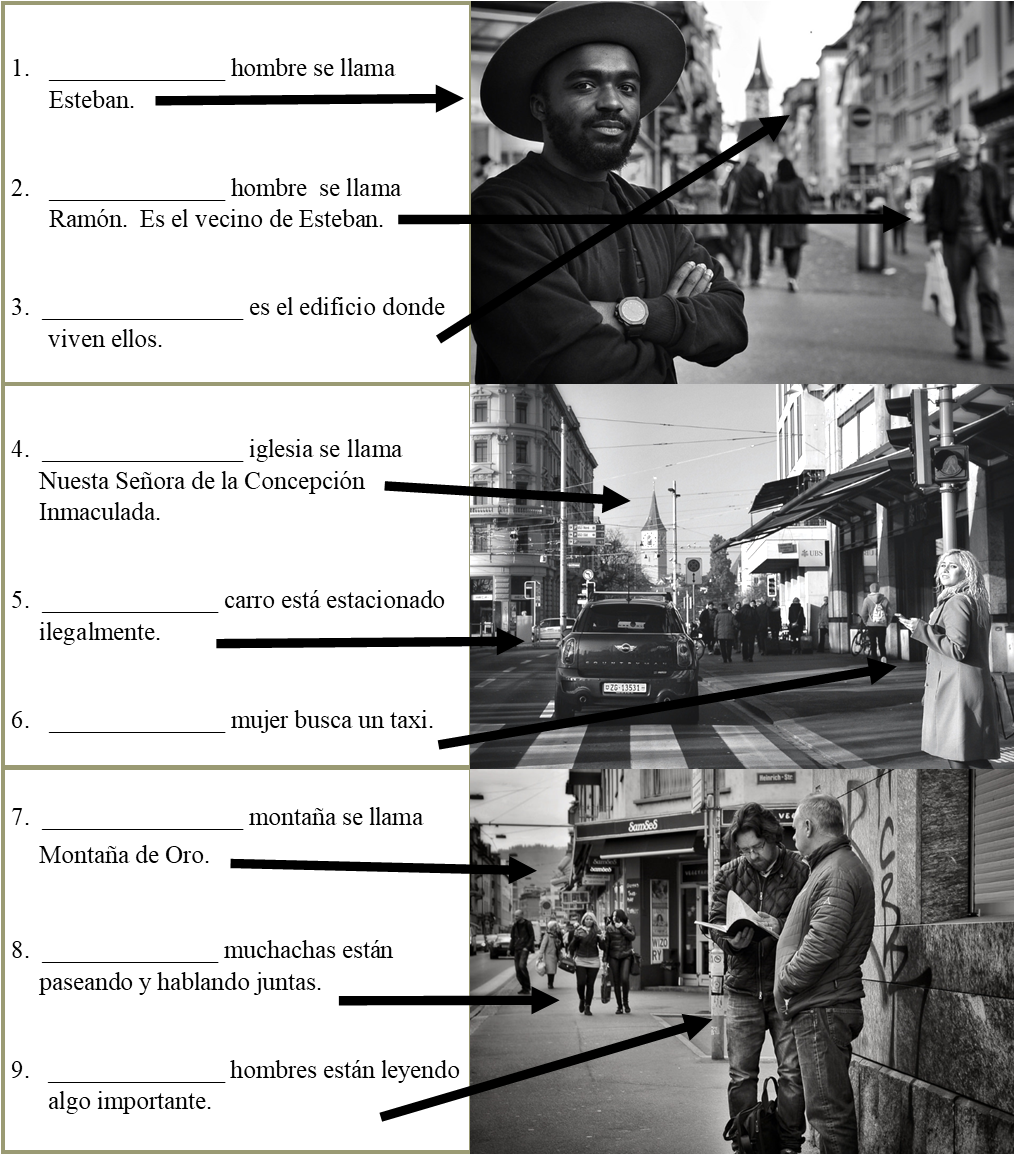6.2: Demonstratives
- Page ID
- 264791
\( \newcommand{\vecs}[1]{\overset { \scriptstyle \rightharpoonup} {\mathbf{#1}} } \)
\( \newcommand{\vecd}[1]{\overset{-\!-\!\rightharpoonup}{\vphantom{a}\smash {#1}}} \)
\( \newcommand{\dsum}{\displaystyle\sum\limits} \)
\( \newcommand{\dint}{\displaystyle\int\limits} \)
\( \newcommand{\dlim}{\displaystyle\lim\limits} \)
\( \newcommand{\id}{\mathrm{id}}\) \( \newcommand{\Span}{\mathrm{span}}\)
( \newcommand{\kernel}{\mathrm{null}\,}\) \( \newcommand{\range}{\mathrm{range}\,}\)
\( \newcommand{\RealPart}{\mathrm{Re}}\) \( \newcommand{\ImaginaryPart}{\mathrm{Im}}\)
\( \newcommand{\Argument}{\mathrm{Arg}}\) \( \newcommand{\norm}[1]{\| #1 \|}\)
\( \newcommand{\inner}[2]{\langle #1, #2 \rangle}\)
\( \newcommand{\Span}{\mathrm{span}}\)
\( \newcommand{\id}{\mathrm{id}}\)
\( \newcommand{\Span}{\mathrm{span}}\)
\( \newcommand{\kernel}{\mathrm{null}\,}\)
\( \newcommand{\range}{\mathrm{range}\,}\)
\( \newcommand{\RealPart}{\mathrm{Re}}\)
\( \newcommand{\ImaginaryPart}{\mathrm{Im}}\)
\( \newcommand{\Argument}{\mathrm{Arg}}\)
\( \newcommand{\norm}[1]{\| #1 \|}\)
\( \newcommand{\inner}[2]{\langle #1, #2 \rangle}\)
\( \newcommand{\Span}{\mathrm{span}}\) \( \newcommand{\AA}{\unicode[.8,0]{x212B}}\)
\( \newcommand{\vectorA}[1]{\vec{#1}} % arrow\)
\( \newcommand{\vectorAt}[1]{\vec{\text{#1}}} % arrow\)
\( \newcommand{\vectorB}[1]{\overset { \scriptstyle \rightharpoonup} {\mathbf{#1}} } \)
\( \newcommand{\vectorC}[1]{\textbf{#1}} \)
\( \newcommand{\vectorD}[1]{\overrightarrow{#1}} \)
\( \newcommand{\vectorDt}[1]{\overrightarrow{\text{#1}}} \)
\( \newcommand{\vectE}[1]{\overset{-\!-\!\rightharpoonup}{\vphantom{a}\smash{\mathbf {#1}}}} \)
\( \newcommand{\vecs}[1]{\overset { \scriptstyle \rightharpoonup} {\mathbf{#1}} } \)
\( \newcommand{\vecd}[1]{\overset{-\!-\!\rightharpoonup}{\vphantom{a}\smash {#1}}} \)
\(\newcommand{\avec}{\mathbf a}\) \(\newcommand{\bvec}{\mathbf b}\) \(\newcommand{\cvec}{\mathbf c}\) \(\newcommand{\dvec}{\mathbf d}\) \(\newcommand{\dtil}{\widetilde{\mathbf d}}\) \(\newcommand{\evec}{\mathbf e}\) \(\newcommand{\fvec}{\mathbf f}\) \(\newcommand{\nvec}{\mathbf n}\) \(\newcommand{\pvec}{\mathbf p}\) \(\newcommand{\qvec}{\mathbf q}\) \(\newcommand{\svec}{\mathbf s}\) \(\newcommand{\tvec}{\mathbf t}\) \(\newcommand{\uvec}{\mathbf u}\) \(\newcommand{\vvec}{\mathbf v}\) \(\newcommand{\wvec}{\mathbf w}\) \(\newcommand{\xvec}{\mathbf x}\) \(\newcommand{\yvec}{\mathbf y}\) \(\newcommand{\zvec}{\mathbf z}\) \(\newcommand{\rvec}{\mathbf r}\) \(\newcommand{\mvec}{\mathbf m}\) \(\newcommand{\zerovec}{\mathbf 0}\) \(\newcommand{\onevec}{\mathbf 1}\) \(\newcommand{\real}{\mathbb R}\) \(\newcommand{\twovec}[2]{\left[\begin{array}{r}#1 \\ #2 \end{array}\right]}\) \(\newcommand{\ctwovec}[2]{\left[\begin{array}{c}#1 \\ #2 \end{array}\right]}\) \(\newcommand{\threevec}[3]{\left[\begin{array}{r}#1 \\ #2 \\ #3 \end{array}\right]}\) \(\newcommand{\cthreevec}[3]{\left[\begin{array}{c}#1 \\ #2 \\ #3 \end{array}\right]}\) \(\newcommand{\fourvec}[4]{\left[\begin{array}{r}#1 \\ #2 \\ #3 \\ #4 \end{array}\right]}\) \(\newcommand{\cfourvec}[4]{\left[\begin{array}{c}#1 \\ #2 \\ #3 \\ #4 \end{array}\right]}\) \(\newcommand{\fivevec}[5]{\left[\begin{array}{r}#1 \\ #2 \\ #3 \\ #4 \\ #5 \\ \end{array}\right]}\) \(\newcommand{\cfivevec}[5]{\left[\begin{array}{c}#1 \\ #2 \\ #3 \\ #4 \\ #5 \\ \end{array}\right]}\) \(\newcommand{\mattwo}[4]{\left[\begin{array}{rr}#1 \amp #2 \\ #3 \amp #4 \\ \end{array}\right]}\) \(\newcommand{\laspan}[1]{\text{Span}\{#1\}}\) \(\newcommand{\bcal}{\cal B}\) \(\newcommand{\ccal}{\cal C}\) \(\newcommand{\scal}{\cal S}\) \(\newcommand{\wcal}{\cal W}\) \(\newcommand{\ecal}{\cal E}\) \(\newcommand{\coords}[2]{\left\{#1\right\}_{#2}}\) \(\newcommand{\gray}[1]{\color{gray}{#1}}\) \(\newcommand{\lgray}[1]{\color{lightgray}{#1}}\) \(\newcommand{\rank}{\operatorname{rank}}\) \(\newcommand{\row}{\text{Row}}\) \(\newcommand{\col}{\text{Col}}\) \(\renewcommand{\row}{\text{Row}}\) \(\newcommand{\nul}{\text{Nul}}\) \(\newcommand{\var}{\text{Var}}\) \(\newcommand{\corr}{\text{corr}}\) \(\newcommand{\len}[1]{\left|#1\right|}\) \(\newcommand{\bbar}{\overline{\bvec}}\) \(\newcommand{\bhat}{\widehat{\bvec}}\) \(\newcommand{\bperp}{\bvec^\perp}\) \(\newcommand{\xhat}{\widehat{\xvec}}\) \(\newcommand{\vhat}{\widehat{\vvec}}\) \(\newcommand{\uhat}{\widehat{\uvec}}\) \(\newcommand{\what}{\widehat{\wvec}}\) \(\newcommand{\Sighat}{\widehat{\Sigma}}\) \(\newcommand{\lt}{<}\) \(\newcommand{\gt}{>}\) \(\newcommand{\amp}{&}\) \(\definecolor{fillinmathshade}{gray}{0.9}\)- Identify the different forms of demonstrative adjectives
- Use demonstrative adjectives to indicate proximity

Demonstratives are used to demonstrate how close something is to the speaker.
They are adjectives when they directly accompany a noun.
Me gusta esta blusa. (This blouse)
They are pronouns when they stand alone (even when they stand alone, they still refer to the noun and must match its gender/number).
¿Qué blusa te gusta más? - - - Esta. (This one)
The English equivalents are:
This and These (for things within the speaker’s reach)
-and-
That and Those (for things outside of the speaker’s reach)
In Spanish, we have a third group for things that are quite far away. We’ll call them:
That and Those way over there
In English, you see that we have a singular and a plural version of each, which is true for Spanish as well. However, we also have to account for gender.



Other notes:
When used as pronouns, some people will put an accent over the first “e.” However, it is no longer required.
We have a neutral “this” and a neutral “that” when we are referring to something abstract (meaning, we are not referring to any specific noun in particular).
Esto:
- ¿Qué es esto?
- Esto es increíble.
Eso:
- ¡Eso es ridículo!
- ¿Qué es eso?
Aquello: This is the neutral “that way over there.” It is much less commonly used than the others.
- Aquello es mío.
Actividad 1
Los adjetivos demostrativos. Fill in the blanks and answer the questions to build your foundation with the demonstrative adjectives.
¿Cómo se dice this? Masculino ___________ Femenino ___________
___________ casa ___________ chico ___________ marcador ___________ clase
¿Cómo se dice these? Masculino ___________ Femenino ___________
___________ perros ___________ plumas ___________ niñas ___________ estudiantes
What is the proximity to the speaker for this and these? ___________
¿Cómo se dice that? Masculino ___________ Femenino ___________
___________ carro ___________ reloj ___________ mujer ___________ farmacia
¿Cómo se dice those? Masculino ___________ Femenino ___________
___________ niños ___________ manzanas ___________ clases _ __________ gatos
What is the proximity to the speaker for that and those? ___________
¿Cómo se dice that way over there? Masculino ___________ Femenino ___________
___________ hombre ___________ casa ___________ árbol ___________ mujer
¿Cómo se dice those way over there? Masculino ___________ Femenino ___________
___________ árboles ___________ casas ___________ montañas ___________ carros
What is the proximity to the speaker for that and those way over there?________

Actividad 2
Los pronombres demostrativos. Fill in the blanks and answer the questions to build your foundation with the demonstrative adjectives.
1. ¿Qué libro lees?
--- ____________. Se llama La casa de los espíritus. (this one)
2. ¿Cuál es tu gorra favorita?
--- ____________. La llevo todos los días. (this one)
3. ¿Qué zapatos te gustan más?
--- ____________. Voy a comprarlos. (these ones)
4. ¿Cuáles son las galletas que te gustan más? --- ____________. Son Marías. (these ones)
5. ¿Cuál es tu carro?
--- ____________; el rojo. (that one)
6. ¿Qué blusa te gusta más?
--- ____________. Me gusta el color. (that one)
7. ¿Qué caramelos buscas?
--- ____________. Son mis favoritos. (those ones)
8. ¿Cuáles son tus pinturas favoritas?
--- ____________. Me encantan (I love) las pinturas modernas (those ones way over there)
Actividad 3
Tus preferencias. First, fill in the blanks using the demonstrative adjectives for “this/these” “that/those” and “that/those way over there.” To give perspective, the items that are farthest away are the smallest photos. Then, discuss the objects/animals with a partner to say which one you like using a demonstrative pronoun.
Model: Estudiante 1: Me gustan estos zapatos (a la izquierda).
Estudiante 2: A mí, no me gustan estos zapatos. Me encantan más estos zapatos rojos.






Actividad 4
Las fotografías. Fill in the blanks using demonstrative adjectives to complete the descriptions of the photos below. Pay attention to foreground, middle ground, and background. Then translate the sentences.

Contributors and Attributions
- 7.5: Demonstratives. Authored by: Erin Heubener. Provided by: LibreTexts. License: CC BY-NC-SA 4.0
- Remixed by Karen Le Cornet. License: CC BY: Attribution


